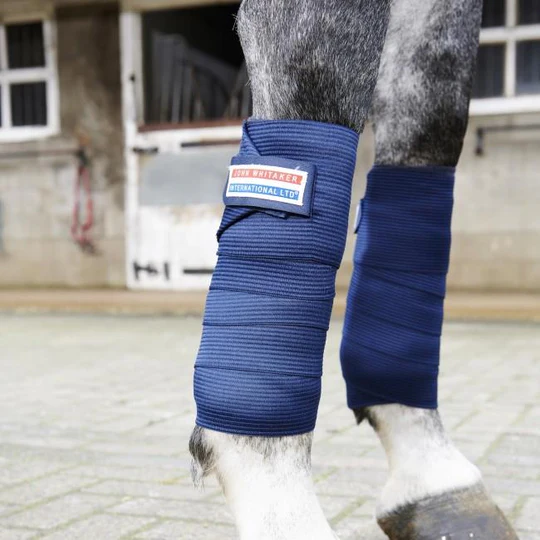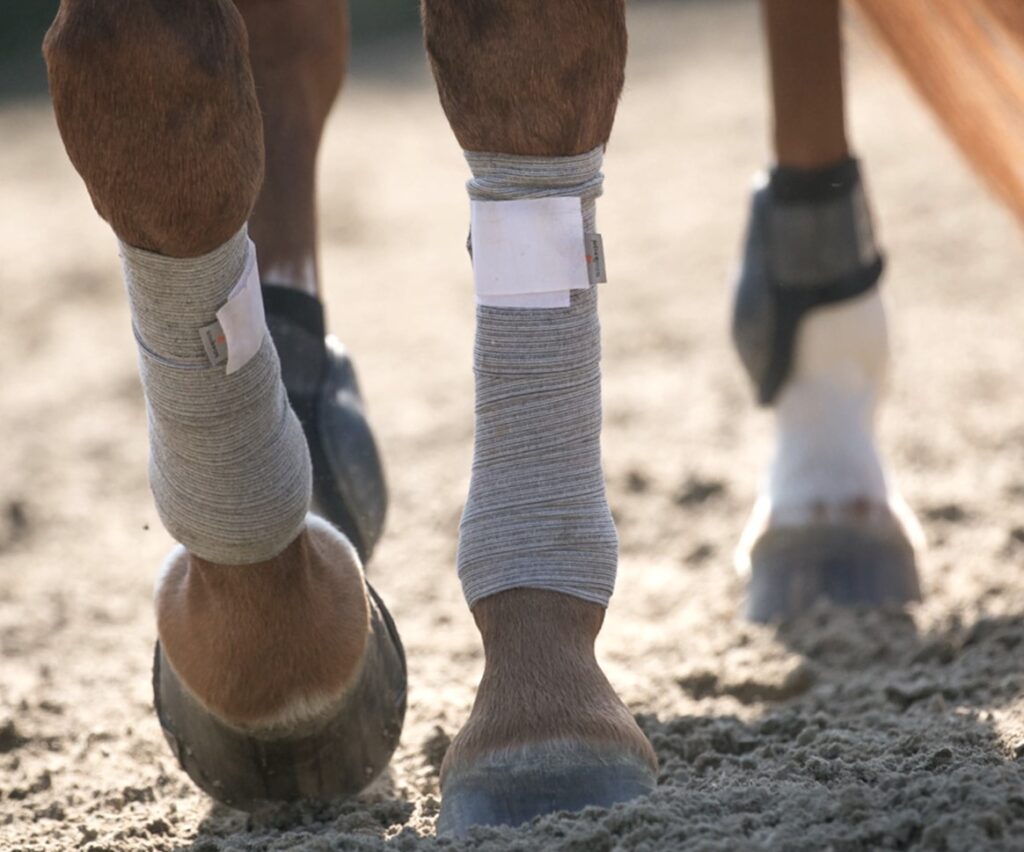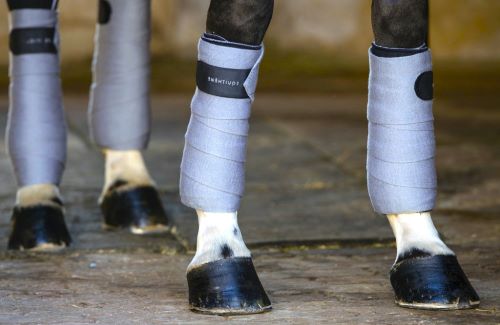As an alternative to boots, exercise bandages offer leg protection and support for horses. However, boots are usually more suitable and user-friendly for young riders.
Reasons to Consider Boots over Bandages
While exercise bandages provide support, they can pose problems when used improperly and are generally less favored by novice handlers.
Reasons to prefer boots include:
- Ease of Use: Boots are faster and easier to put on correctly.
- Risk of Improper Use: Ill-fitted bandages could be exceedingly painful for a horse and may cause long-lasting damage. For those wanting to use exercise bandages, guidance from an experienced professional is recommended.

Characteristics of Exercise Bandages
Exercise bandages are made from stretchy cotton crepe that measures about 6 cms (3 ins) wide and around 2 meters (6 ft) long. They are secured using either tapes, Velcro, or clips. Proper padding should always be used under the bandage.
Key aspects of exercise bandages are:
- Material: Stretchy cotton crepe.
- Dimensions: Approximately 6 cms wide and 2 meters long.
- Fastening Methods: Tapes, Velcro, or clips.
Padding for Bandages
Padding is crucial to provide even pressure, added protection, warmth, and support. Ensure the padding is cut to the correct size for the horse’s leg.
Available padding types include:
- Gamgee: Traditional soft cotton-wool lined with gauze. Despite its efficiency, Gamgee can become dirty quickly and appear scruffy if not cut neatly.
- Synthetic Fybagee: Reusable synthetic padding.
- Shock-Absorbing Shells: Spongy, shock-absorbing shells that mold to fit around the tendons. This padding is popular among cross-country riders.
Applying Exercise Bandages
To properly apply exercise bandages, follow these steps:
- Positioning the Padding: Wrap the padding around the leg, ensuring it doesn’t interfere with the movement of the joints. The bandage should cover the area from below the knee to above the fetlock.
- Securing the Bandage: Hold approximately 10 cms of bandage at an angle against the leg below the knee. Wrap it around once to secure it before wrapping it down the leg using firm, even pressure. Ensure each turn covers about two-thirds of the previous wrap. Be cautious not to wrap too tightly or loosely, as a tight bandage can damage the leg, while a loose one could slip or come undone.
- Finishing the Bandage: Stop bandaging above the fetlock and work upwards again to finish.
- Fastening the Ends: Fasten the bandage only on the outside of the leg, avoiding the inside, front, or back. If using tapes, ensure they lie flat before tying them in a double bow and tucking in the ends. Ties can be stitched for additional security or taped over. Be careful not to tighten the ties or tape more than the bandage itself, as this could cause them to dig into the leg.
Care and Maintenance of Exercise Bandages

The importance of proper care and maintenance of exercise bandages cannot be overstated. It’s crucial to keep an eye on the time bandages spend on the horse’s legs, especially when they’ve become damp or wet. Proper removal and post-usage care can significantly impact the health of the horse’s legs.
Duration of Exercise Bandage Use
Understanding the right duration for keeping a bandage on a horse’s leg is imperative. Leaving a wet or damp bandage on for an extended period could lead to health complications.
Key considerations include:
- Timed Use: Ensure not to leave exercise bandages on for too long.
- Moisture Concerns: Track whether bandages have become damp or wet, as moisture can lead to health complications when left unaddressed for prolonged periods.
Removing Exercise Bandages
The removal of exercise bandages should be done carefully and in a specific manner to prevent any unwanted strain on the horse’s leg.
Instructions for removing exercise bandages encompass:
- Be Gentle: Carefully and slowly unwind the bandage.
- Alternate Hands: Pass the bandage from one hand to the other as you unwind it.
- Avoid Pulling: Avoid pulling on the bandage or causing any discomfort or strain to the horse’s leg during the unwinding process.
Post-Removal Care
Once bandages are removed, it’s crucial to stimulate circulation within the horse’s leg with a gentle massage.
Post-removal steps include:
- Massage: Massaging each leg gently can help restore normal blood circulation.
- Assessment: Check for any noticeable abnormalities or signs of distress after removing the bandages.
- Extra Attention: Focus on particularly tense areas or parts of the leg that had been under more pressure from the bandages.
By following these guidelines, horse owners and trainers can ensure the health and comfort of their equine partners, making the most of protective measures such as exercise bandages.
Application and Usage of Stable Bandages

Stable bandages differ from exercise bandages in their design and usage. They are generally thicker, wider and longer, usually crafted from stretchy fabric such as wool jersey or cotton stockinette. Unlike exercise bandages, they are not used for riding but provide warmth, support, protection, and assist in first aid treatments for equine legs.
Purposes and Characteristics of Stable Bandages
The key characteristics and purposes of stable bandages include:
- Rest and Recovery: Stable bandages provide support to tired or injured legs, aiding recovery.
- Material and Construction: Typically made from stretchier, comfortable materials like wool jersey or cotton stockinette.
- Transport Protection: To safeguard the horse’s legs during travel.
- First Aid Assistance: They can cover wounds or keep a poultice in place.
- Extra Coverage: Stable bandages cover more of the leg, extending from just below the knee or hock, down over the fetlock to the coronet.
Procedure for Applying Stable Bandages
Applying stable bandages requires a methodical approach to ensure they provide maximum benefit without causing discomfort to the horse.
The step-by-step process includes:
- Wrap Padding: Ensure the padding wraps around the leg and is long enough to provide full coverage. For traveling, it is recommended to extend the padding to cover the knee or hock and the coronet. Unravel approximately 8 cms (4 ins) of the bandage and hold it at an angle against the outside of the leg. Wrap once around the leg, tucking in the end as you go.
- Wind Bandage: Continue rolling evenly down the leg, with each turn covering about half of the previous round. Wrap over the fetlock and pastern at an angle, then start moving upward again, finishing approximately halfway up the cannon bone.
- Secure Fastening: Fasten the bandage securely. Ensure ties are not twisted and are knotted into a bow with ends tucked safely in.
Maintenance of Stable Bandages
Proper care and maintenance of the stable bandages are essential to preserve their effectiveness and longevity.
Key aspects of bandage maintenance encompass:
- Cleaning: Regularly clean bandages to ensure they are free of dirt and grime.
- Rolling: Roll them up tightly and evenly, eliminating wrinkles to allow smooth application on the leg. When you roll up a bandage, start with the pointed end on the outside. Lay the tapes or Velcro flat and roll them in – this way, they will be in the correct position when you bandage next time.
With meticulous application and appropriate care, stable bandages can notably benefit a horse’s wellbeing, contributing to its comfort and safety in various scenarios.










